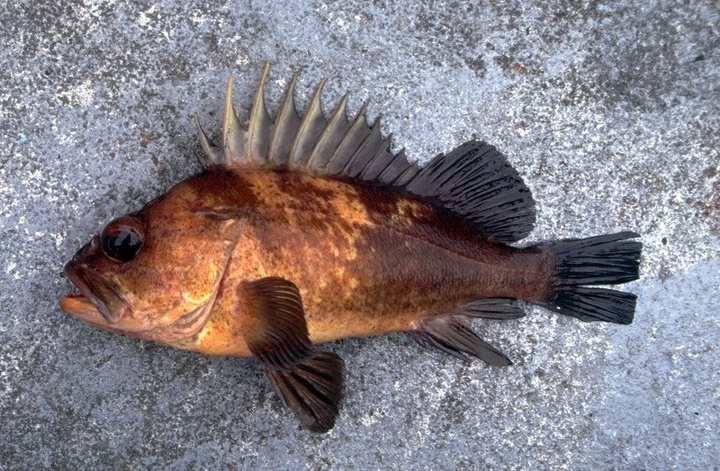Jessica Cejnar Andrews / Wednesday, May 8, 2024 @ 4:20 p.m. / Ocean
Crescent City Harbor Commissioners Take Issue With 'Disparity' Between Fishing in Brookings and Fishing in Del Norte County

The quillback rockfish was at the center of last year's groundfish season closure. | Courtesy of California Department of Fish & Wildlife
A month after California's commercial and recreational salmon fishery was canceled, one Crescent City Harbor is calling on fishery managers to reconsider what he says are stringent regulations.
Commissioner Rick Shepherd, a long-time commercial fisherman, seeks to draw attention to the disparity between fishing in Brookings and fishing in Crescent City.
Mentioning California's salmon as well as the groundfish and lingcod fisheries, Shepherd is urging the Pacific Fishery Management Council and California Department of Fish and Wildlife to establish a boundary that allows local anglers access equal to their counterparts over the state line.
On Tuesday, Shepherd presented a draft letter to his colleagues that he aims to send to PFMC and CDFW officials, including Director Charlton Bonham, as well as to Congressman Jared Huffman. Though CCHD Board President Harry Adams read the letter aloud, Shepherd said it was a work in progress.
“Despite our proximity, Crescent City faces significantly restrictive fishing regulations starkly contrasting with those allowed in Brookings, Oregon,” Shepherd states in his letter. “Notable, Oregon permits an annual limit of 5,500 pounds of lingcod whereas California has set this limit at zero for our waters. Additionally, the Pacific Fishery Management Council has sanctioned a nearly unrestricted salmon season in Brookings and Crescent City has been excluded from salmon fishing entirely.”
Shepherd said the reference to a 5,500 pound lingcod limit for commercial fishermen in Oregon equates to about 15,000 pounds per month “that’s denied our fishermen in Crescent City.”
“That’s $180,000 per boat in our harbor is the difference on that one regulation alone,” he said. “And it’s absolutely not necessary whatsoever.”
Shepherd’s proposed letter comes after the Pacific Fishery Management Council voted last month to cancel all commercial and recreational salmon fishing off the California coast for a second year in a row.
In a March 11 article, CalMatters reported that last year's closure cost about $45 million statewide. The commercial season typically starts in May and ends in October.
In Oregon, between Cape Falcon and Humbug Mountain, ocean commercial fisheries will be open through late May and then shift to a “pulse of openers” lasting a few days in June, July and August before being open for September and October, according to a PFMC news release April 10.
The area between Humbug Mountain and the California state line was open to commercial salmon fishing briefly from mid-to-late April. Sport anglers from Humbug Mountain to the California state line will be able to fish for chinook from late May through August, according to the PFMC’s news release.
As for groundfishing, the PFMC in March approved a recreational season north of the Monterey Bay Area shoreward of 50 fathoms, or 300 feet, last month. From May through September, anglers will be able to fish shoreward of 20 fathoms, or 120 feet. During October, recreational fishermen will be able to return to fishing shoreward of 50 fathoms. That boundary sinks again to 20 fathoms in November and returns to 50 fathoms in December.
The PFMC’s 2024 groundfish regulations set a two-fish quota for vermilion rockfish, prohibited fishermen from keeping quillback rockfish and required anglers to carry a descending device to limit fish mortality.
On Tuesday, Andrea Spahn, a member of the Crescent City Fishing Group, which was formed in the wake of CDFW’s groundfish season closure in August and has been advocating for reopening the season, said the Crescent City Harbor District may want to think twice before comparing Crescent City to Oregon.
Sport fishermen in Oregon are allowed to keep two lingcod and five rockfish, Spahn said and will likely have their groundfish quota cut to four or three next year.
Spahn also argued against trying to get year-round fishing stating that fish need “some time off” to spawn. Lingcod spawn between January and March, she said.
“The thing we really need to work on is getting a Northern Management Zone separated for us because of the fact that our rockfishing out here is 30 fathoms shoreward,” she said. “In Eureka down further, they love the 50 fathoms because they don’t have any shallow fishing.”
CDFW classifies the Northern Management Area as extending from Cape Mendocino to the Oregon border.
Spahn also pointed to statements NOAA scientists made at a March 20 community meeting that limiting the nearshore groundfish fishery to 20 fathoms reduces quillback mortality to 9 percent.
She also emphasized the need for better data regarding the quillback rockfish, the species that prompted last year’s closure.
“NOAA was here in March,” she said. “We fished with them, but they can’t come until they get more funding and we need them here now. We need that data. We need to know what’s out there.”
Shepherd said there was more in his letter than Adams read aloud. His colleague, Brian Stone, asked Shepherd who he wanted to send the letter to, suggesting that State Sen. Mike McGuire should be one of the recipients.
Stone also called for tabling the issue until he had a chance to read Shepherd’s letter and see if he wanted to make changes.
CLICK TO MANAGE